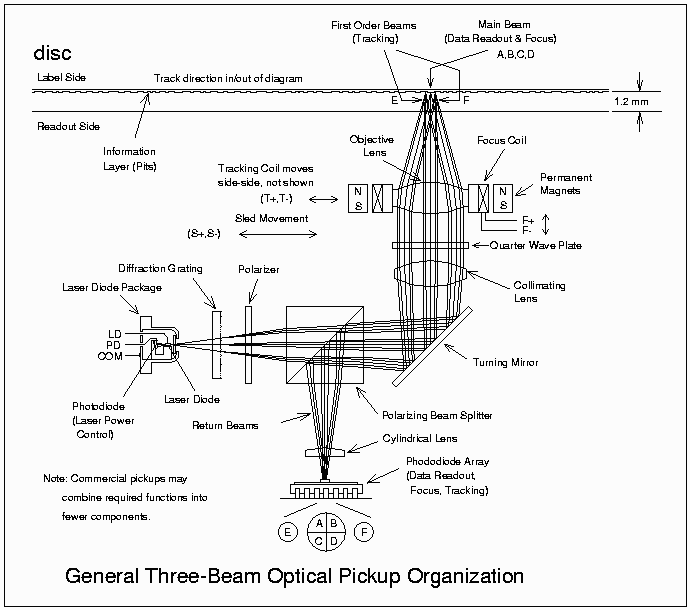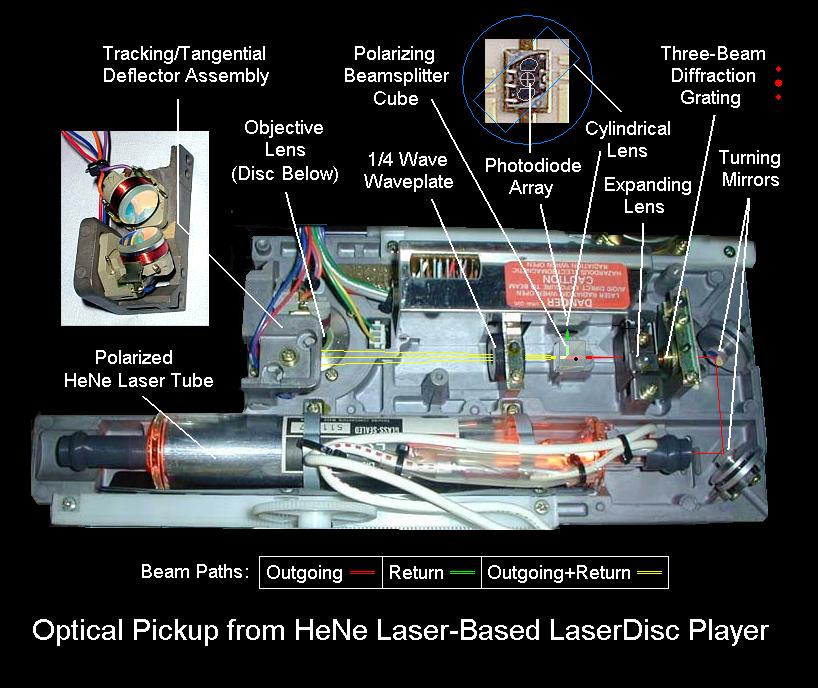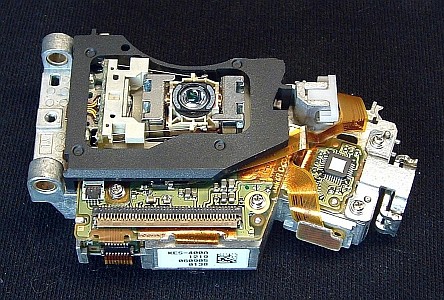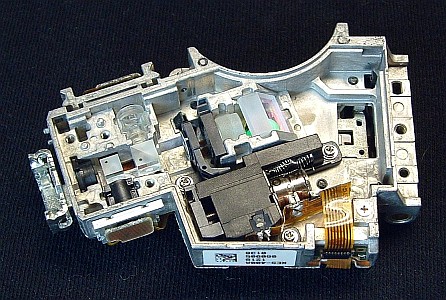
In 1978, Magnvox introduced the LaserDisc (LD) system, called "DiscoVision", although it wasn't until around 1980 with Pioneer's VP1000 that it became reasonably reliable for the general public. LD was a technological tour-de-force providing video and audio quality far superior to the VCR and arguably competitive with the DVD (which didn't appear until over 2 decades later). However, LD was never more than a niche product due to the high cost of the players (think $1,000 in 1980 dollars), limited prgram material, and probably of most significance, that unlike the VCR, it could not record. (Nonetheless, LD did hang on beyond 2000 and is still coveted by some aficionados. And in praise of the early LD technology, many of those players from the early 1980s still work perfectly.)
Information on all common optical media is encoded on a spiral track in the form of minute 'pits' buried behind a protective transparent plastic layer. On an CD, this layer is most of the media's thickness, about 1.2 mm while on DVDs and Blu-ray discs (BDs), it is 0.6 and 0.1 mm, respectively, to accomodate higher numerical aperture (N.A.) of the readout optics. (On the LD, it is 1.2 mm but the LD is a sandwidth of two discs cemented together with program material on both sides so the total thinkness is around 2.4 mm.)
The original CD (or other disc) master is generated on a precision "lathe" which may use an interferemoter for positioning and a high power laser to literally blast the pits in the master's surface. Several plating and strip-off steps result in "stampers" which are used to press the CDs from softened plastic in much the same way as an old style LP record, but under much more stringent conditions - similar to those maintained in the clean room of a semiconductor wafer fab. The CD pressing is then aluminum coated in a vacuum chamber and the label side is spin-coated with a protective plastic resin and printed with the label.
Few people appreciate the marvel of modern technology lurking inside their DVD drive or Blu-ray player. The information pits are order of the width of the wavelength of the light used for their recording and playback, with their length varying in much smaller increments. The optical pickup must maintain precise focus of a diffraction-limited laser beam on the information layer, stay on the track, detect the reflected optical beam and convert it to an electrical signal.
Figure 1 shows the organization of a typical optical pickup. This one is for a CD player, but all must perform the same functions.

This design is typical of older optical pickups (though you may come across some of these). Newer types have far fewer individual parts combining and eliminating certain components without sacrificing performance (which may even be better). Additional benefits result is lower cost, improved robustness, and increased reliability. However, operating principles are similar.
The purpose of the optical pickup in a CD player, CDROM drive, or optical disk drive, is to recover digital data from the encoded pits at the information layer of the optical medium. (With recordable optical disks, it is also used to write to the disk medium.) For CD players, the resulting datastream is converted into high fidelity sound. For CDROMs or other optical storage devices, it may be interpreted as program code, text, audio or video multimedia, color photographs, or other types of digital data.
Most of the basic operating principles are similar for single-beam CD pickups and for pickups used in other digital optical drives.
It is often stated that the laser beam in a CD player is like the stylus of a phonograph turntable. While this is a true statement, the actual magnitude of this achievement is usually overlooked. Consider that the phonograph stylus is electromechanical. Stylus positioning - analogous to tracking and focus in an optical pickup - is based on the stylus riding in the record's grooves controlled by the suspension of the pickup cartridge and tone arm. The analog audio is sensed most often by electromagnetic induction produced by the stylus's minute movements wiggling a magnet within a pair of sense coils.
The optical pickup must perform all of these functions without any mechanical assistance from the CD. It is guided only be a fraction of a mW of laser light and a few milligrams of silicon based electronic circuitry.
Furthermore, the precision involved is easily more than 2 orders of magnitude finer compared to a phonograph. Sophisticated servo systems maintain focus and tracking to within a fraction of a micrometer of optimal. (1 um is equal to 1/25,400 of an inch). Data is read out by detecting the difference in depth of pits and lands of 1/4 wavelength of laser light (about 0.15 um in the CD)!
Note that despite what some people believe, the laser diode in a CD or DVD player is a true laser and not just a glorified LED. It has a gain medium (the semiconductor), mirrors (on the cleaved parallel ends of the crystal), and an means of excitation (electric current). Its nearly monochromatic single spatial mode (TEM00) beam can be focused to a spot less than 2 um in diameter. No LED or other non-laser light source is capable of this kind of performance.
The return beams from the disc's information layer are used for servo control of focus and tracking and for data recovery.
The central part of the photodiode array is divided into 4 equal quadrants labeled A,B,C,D. Focus is perfect when the signal = (A+C)-(B+D) = 0.
The actual implementation may use a thick beam splitter mirror (which adds astigmatism) or an astigmatic objective lens rather than a separate cylindrical lens to reduce cost but the effect is the same. Since the objective lens is molded plastic, it costs no more to mold an astigmat (though grinding the original molds may have been a treat!). It is even possible that in some cases, the natural astigmatism of the laser diode itself plays a part in this process.
Segments on either side of the photodiode array designated E and F monitor the side beams. Tracking is perfect when the E and F signals are equal.
In essence, the optical pickup is an electronically steered and stabilized microscope which is extracting information from tracks 1/20 the width of a human red blood cell while flying along at a linear velocity of 1.2 meters per second!
Figure 2 is an annotated photograph of the optical pickup (or "slider" as it was generally called) for the Pioneer LD660 LaserDisc player, circa 1980. The Helium-Neon (HeNe) laser tube and all optical components were mounted on a massive casting that moved on a ball-bearing track. The optics were more or less off-the-shelf and state-of-the art for the day.

Note that essentially all of the major components described above are present in this ancient pickup.
CD technology was developed late enough that suitable low cost IR laser diodes were available to replace the bulky HeNe laser tube. With the laser now being the size of a pea, there was of course great impetus to reduce the size of everything else! Early CD pickups used very similar (but miniaturized) versions of the components in the LD slider. Later versions merged multiple functions to reduce size and cost.
Figure 3 shows three views of a cost reduced optimized CD player optical pickup. The laser diode, photodiode, and associated array are combined into a single can-type package called a "hologram laser" due to the use of a Holographic Optical Element (HOE) built into it. Thus, very few other components are required.

Figure 4 are two views of a first generation combined CD/DVD/Blu-ray optical pickup, originally found in the Sony Playstation 3. This is slightly larger than the CD pickup, but it must handle three wavelengths for the CD, DVD, and Blu-ray - 780 nm, 650 nm, and 405 nm, respectively. The sophistication and complexity of these pickups is truly amazing. All optics are lab-quality and include a micro-stepper motor adjustable zoom lens, custom LCD device and zoneplate for wavefront correction, multi-wavelength QWP, two PBS cubes, and multli-element high NA objective lens on voice coil positioner for focus and tracking.

